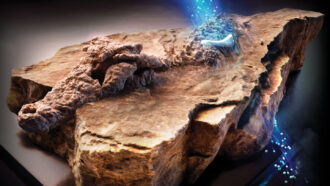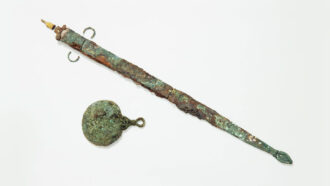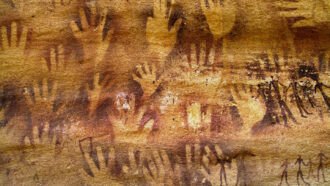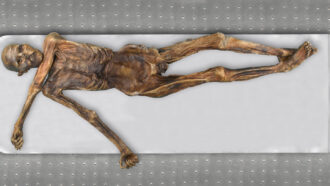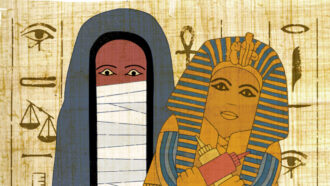A medieval grave may have held a powerful nonbinary person
The remains were once thought to be a respected woman who might have been a warrior
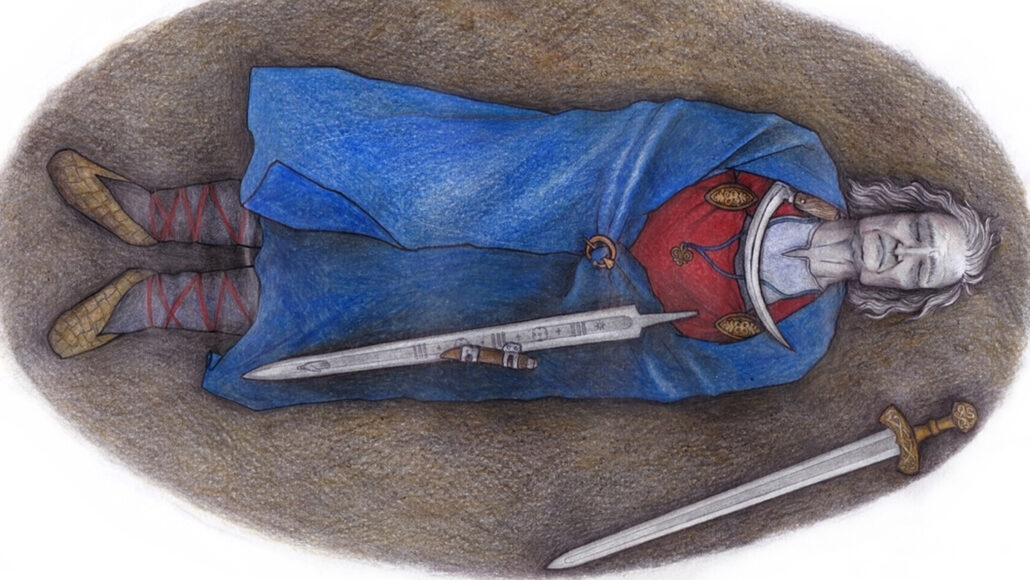
An early medieval grave in Finland may have contained the remains of a respected person (illustrated). This individual didn’t fit social expectations at the time about how to be either strictly masculine or feminine, researchers say.
U. Moilanen et al/European Journal of Archaeology 2021
By Bruce Bower
For decades, a medieval grave in southern Finland had been thought to hold a powerful woman. She might even have been a warrior. But that story may be wrong. The individual may have been biologically male, researchers now say. And there are signs that this person was perhaps a respected person with a nontraditional gender identity.
The grave was discovered in 1968 at a site known as Suontaka. It held a largely decomposed human skeleton. Only two leg-bone fragments were successfully excavated. The grave included jewelry usually associated with women. But there also were two swords typically used by men. One had a bronze hilt. Items in the grave date to between 1050 and 1300. That’s the latter part of Finland’s early medieval period.
Ulla Moilanen works at the University of Turku in Finland as an archaeologist. Moilanen’s team analyzed of a tiny amount of DNA from a leg-bone fragment. That analysis suggests that the grave held a person born with one Y chromosome and two X chromosomes. Normally, a male has an X and Y chromosome; a female has two X’s. This person was XXY. This condition is known as Klinefelter syndrome. Symptoms in present-day males include low testosterone, a lack of facial and body hair and enlarged breasts. People with this condition may also have learning and language-related problems. Effects of this rare condition on growth and appearance range from mild to noticeable.

Educators and Parents, Sign Up for The Cheat Sheet
Weekly updates to help you use Science News Explores in the learning environment
Thank you for signing up!
There was a problem signing you up.
That genetic evidence, combined with the unusual mix of items in the grave, suggests that the grave held someone who was nonbinary, the team says. Gender identity refers to a person’s concept of self as male, female, a blend of both or neither. It often, but not always, coincides with a person’s biological sex. Nonbinary individuals have gender identities that are not strictly male or female.
Early medieval societies often emphasized masculinity and warfare. Even then, some people didn’t fit expectations about how males and females should behave. These people may have been interred in ways that paid tribute to their nontraditional social gender identities. That’s what the scientists conclude July 15 in the European Journal of Archaeology.
“This burial [at Suontaka] has an unusual and strong mixture of feminine and masculine symbolism,” Moilanen says. “This might indicate that the individual was not strictly associated with either gender.”
A mix of evidence
Men today vary greatly in their responses to Klinefelter syndrome, says Chris Kraft. He’s a psychologist who codirects clinical services at the Johns Hopkins School of Medicine Sex and Gender Clinic. It’s in Baltimore, Md. Some men with Klinefelter syndrome develop nontraditional gender identities, he notes. Others express confusion about their gender identity. But many men with the condition adopt a traditional gender identity for their biological sex. Reasons for these differences are poorly understood.
“It’s hard to know how someone in early medieval Finland would have reacted to having Klinefelter syndrome,” Kraft says.
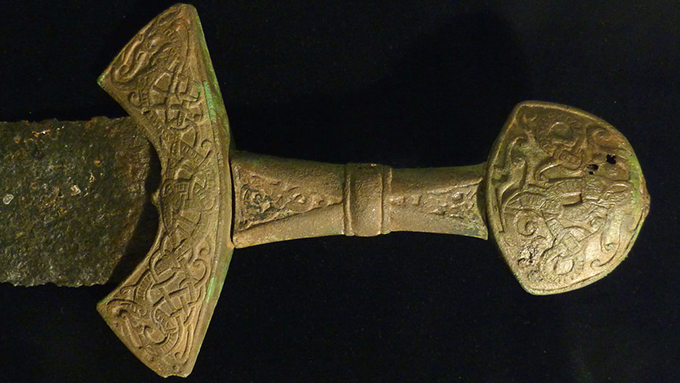
But biology isn’t the only clue about the Suontaka individual. There’s that curious mix of male and female items found in the grave. Moilanen’s group studied 23 animal hairs and three bird feather fragments. These had been retrieved from soil excavated with the leg-bone fragments. Based on that evidence, the person in the grave was likely dressed in feminine clothes. Those clothes were made of sheep’s wool and furs from animals that included rabbits or hares. Bird feathers came from a pillow or bedding. There were also brooches placed in the grave. All these items were associated with females, the team suspects.
A hiltless sword, though, was apparently placed on top of the person’s body at the time of burial. That is something closely tied to early medieval ideas about masculinity. A fancier sword with a carved bronze hilt was probably placed next to the body later. That may have been a sign of continuing respect for the individual, the team suggests.
Where this grave fits
The new study suggests that the grave held a respected person, says Marianne Moen. And that person had neither a typical male nor female sense of their social gender identity. Moen is an archaeologist at the University of Oslo in Norway. She was not part of Moilanen’s group.
But even if the grave held a woman with swords and jewelry, that would say something, Moen adds. The evidence would indicate that some people with outside-of-the-box identities were respected in early medieval Finland. And perhaps elsewhere, too, in Scandinavia. (That’s the region of modern Finland, Norway, Sweden and Denmark.)
Other researchers have made a controversial proposal about a grave in Sweden. It’s some 1,000 years old. The researchers think the grave held the remains either of a Viking warrior woman or a woman buried with the apparel and weapons of a warrior.
There have been rare instances in Scandinavia of early medieval graves with men buried with jewelry. These graves may also have had other feminine items. Perhaps the closest parallel to the Suontaka individual is a man who was interred at Vivallen, Sweden. He was buried nearly 1,000 years ago in the attire of both high-ranking males and females. He was also buried with jewelry and a small knife, Moilanen says. Some researchers suspect that this man was a ritual leader, such as a shaman. There is evidence that shamans in early medieval Scandinavia dressed in women’s clothes.
